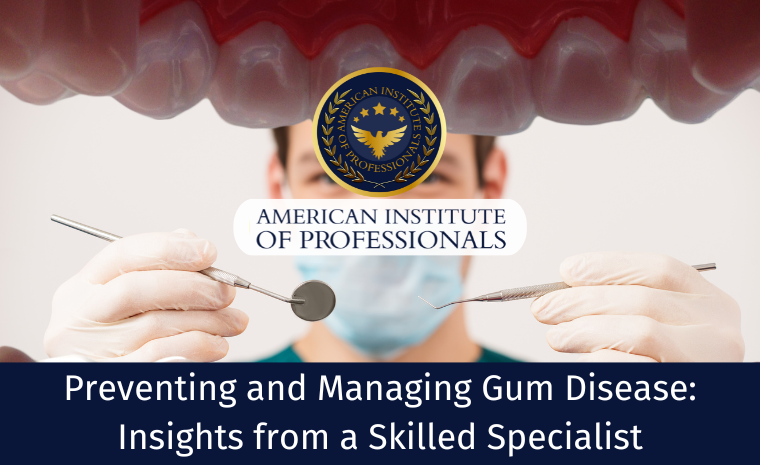Gum disease, also known as periodontal disease, is a common oral health issue that affects a significant number of individuals worldwide. It is characterized by inflammation of the gums and can lead to serious complications if left untreated. Fortunately, there are effective strategies for preventing and managing gum disease.
In this article, we will share insights from a skilled specialist on how to prevent and manage gum disease. You’ll learn about the signs and symptoms of gum disease, the importance of regular dental checkups, and tips for maintaining good oral hygiene.
Understanding Gum Disease
Gum disease is a bacterial infection, that affects the issues surrounding and supporting the teeth. The process often begins with the development of plaque, a sticky film of bacteria that builds up on the teeth and gum line.
If not removed through proper oral hygiene practices, plaque can harden into tartar, which is more difficult to remove and can cause further damage to the gums. In severe cases, teeth may loosen or require extraction.

Common Causes of Gum Disease
Several factors contribute to the development of gum disease. Poor oral hygiene, such as inadequate brushing and flossing, can lead to the buildup of plaque and tartar, irritating the gums and resulting in gum disease.
Smoking and tobacco are other factors, these can weaken the immune system and affect blood flow to the gums, increasing the risk of gum disease. Hormonal changes during puberty, pregnancy, and menopause can make the gums more sensitive and prone to inflammation.
Conditions like diabetes, medications that cause dry mouth, genetic factors, poor nutrition, and chronic stress can also contribute to the development of this disease. Understanding these causes can help individuals take proactive steps to prevent gum disease.
Common signs and symptoms can include swollen, red, or tender gums, bleeding gums when brushing or flossing, receding gums or teeth appearing longer than usual, persistent bad breath, or a bad taste in the mouth.
Definition and Types of Gum Disease
Periodontal disease, or gum disease, is a condition that impacts the gums and supporting tissues around teeth. According to a report by the Centers for Disease Control and Prevention, 47.2% of adults aged 30 and above in the United States have some form of this disease. The prevalence of gum disease increases with age, with 70.1% of adults aged 65 and above experiencing some type of gum disease.
Some types are:
Gingivitis
Gingivitis is the mildest form of gum disease and is caused by the buildup of plaque on teeth. Plaque is a sticky film of bacteria that forms on teeth and can cause inflammation of the gums. Symptoms of gingivitis include red, swollen, and bleeding gums. It is important to treat gingivitis early on to prevent it from progressing to a more severe form of gum disease.
Periodontitis
Periodontitis is a serious disease that can lead to permanent damage to the gums, teeth, and supporting bone. Occurs when plaque buildup goes below the gum line and causes an infection. Signs of periodontitis include receding gums, loose teeth, and bad breath. To treat periodontitis, deep cleaning procedures like scaling and root planing are used, and in severe cases, surgery is necessary.
Chronic periodontitis
Chronic periodontitis is the most common form of periodontitis and is characterized by inflammation and progressive loss of attachment between the teeth and gums. It can lead to tooth loss if left untreated and is typically caused by poor oral hygiene habits and the buildup of plaque and tartar.
Aggressive periodontitis
Aggressive periodontitis is a less common form of periodontitis that typically affects younger individuals and is characterized by rapid destruction of the gums and bone supporting the teeth. It is caused by a genetic predisposition to the disease and can lead to tooth loss if left untreated.
Necrotizing periodontal disease
Necrotizing periodontal disease is a rare and severe form of periodontal disease that is characterized by the death of gum tissue, bone, and ligaments supporting the teeth. It is typically caused by a bacterial infection and can lead to tooth loss if left untreated. Symptoms of necrotizing periodontal disease include severe pain, bleeding, and foul odor from the mouth.
Periodontal abscess
A periodontal abscess is a localized collection of pus that forms in the gums or bone supporting the teeth. It is typically caused by a bacterial infection and can be very painful. Treatment for a periodontal abscess includes draining the pus and prescribing antibiotics.
Refractory periodontitis
Refractory periodontitis is a form of gum disease that is resistant to treatment. It occurs when the bacteria causing the disease are resistant to antibiotics or when there are underlying systemic conditions that make it difficult to control the infection. Treatment for refractory periodontitis may require a combination of antibiotics, surgery, and other advanced treatment options.
Importance of Regular Dental Check-ups
Regular checkups play a vital role in preventing and managing gum disease. Skilled dental specialists can detect early signs of gum disease, provide professional cleanings to remove dental plaque and tartar, and offer personalized advice on maintaining optimal oral health.
If you are already suffering from periodontal disease, it is necessary to see your periodontist regularly, as well as follow these steps to help with your problem:
Practice good oral hygiene
To maintain good dental hygiene, brush your teeth twice a day using a soft-bristled toothbrush and fluoride toothpaste. Ensure that you clean along the gum line to eliminate plaque and bacteria that can lead to gum disease. Remember to floss daily to eliminate plaque and food particles from between your teeth and along the gum line.
Use an antimicrobial mouthwash
Rinse your mouth with an antimicrobial mouthwash to help reduce plaque and gingivitis-causing bacteria. Look for a mouthwash that contains ingredients like chlorhexidine or essential oils like tea tree oil.
Maintain a healthy diet
Eat a balanced diet rich in fruits, vegetables, whole grains, and lean proteins. Avoid sugary and starchy foods as they can contribute to plaque buildup and increase the risk of gum disease. Drinking plenty of water also helps to flush out bacteria and keep your mouth hydrated.
Quit smoking
Smoking is a significant risk factor for gum disease. It weakens the immune system, impairs blood flow to the gums, and slows down the healing process. Quitting smoking can significantly improve the health of your gums.
Manage stress
Stress can weaken the immune system and make it more difficult for your body to fight off gum infections. Find healthy ways to manage stress, such as exercising regularly, practicing relaxation techniques, or seeking support from friends and family.
Remember, early detection and treatment of gum disease are crucial for preventing further damage. If you notice any signs of gum disease, contact our experienced team now.
Take Control Of Your Oral Health Today!
Maintaining healthy gums is a fundamental aspect of overall oral health. By following effective preventive measures, practicing good oral hygiene, seeking professional care, and adopting a healthy lifestyle, individuals can significantly reduce the risk of developing gum disease.
Regular check-ups with skilled dental specialists and proactive efforts in preventing and managing gum disease contribute to a confident and healthy smile. Take the first step towards a healthier mouth by making your oral health a priority! Contact a specialist to schedule an appointment.





